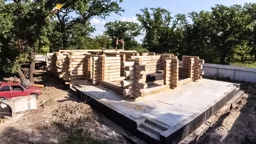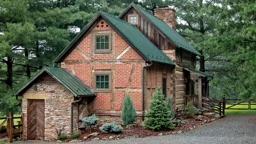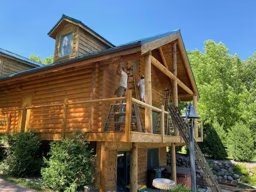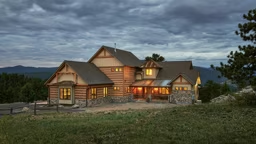| Planning & Building a Basement: 7 Ways to Create a Functional and Affordable Basement Space |
The basement is the best building deal in your house. Here are 7 ways to create a functional and affordable space.

1. What are the best flooring materials for my basement? The least expensive basement floor is…concrete. Surprised? Many folks are, but it’s really a smart choice for some houses. If you plan to use concrete as a finished surface, be sure to tell the contractor that you want a “troweled” finish, which will be much smoother than the utility surface found in unfinished basements. Consider using dyed concrete, and be sure you or your contractor applies a sealant while the floor is clean. It will be hard to remove the effects of construction traffic and debris from an unsealed floor when construction is completed. If you plan to use your concrete slab as a finished floor, ask your contractor to place a layer of rigid insulation and radiant barrier beneath the slab. This also is one of the most economical ways to add radiant-floor heat to your home. Of course, you aren’t limited to concrete for your finished floor. Stone and tile add elegant touches, but they also hit your budget harder. Carpet and vinyl flooring provide economical alternatives. If you elect to use wood, be sure to isolate the wood away from the dampness of the concrete slab. And you might play it safe and go with engineered wood, since it’s not as prone to shift in response to changes in temperature and humidity than solid wood.
2. What are the advantages of finishing the basement when we first build our house? When you finish your basement during construction, all of the subcontractors are already onsite, which means they can offer you (or, most likely, your builder) their best price. Finishing early also means that your basement layout will be integrated into the rest of construction. Subcontractors will be able to work more efficiently, use fewer materials and resolve issues such as pipe and wire placement as they arise—rather than leaving something that will create problems during future construction. Bottom line: To get the biggest bang for your home-buying buck, finish the basement at the time of construction.
3. If I choose to hold off on finishing my log home basement because of budgetary constraints, what should my contractor do to ensure a smooth finishing process in several years? First, even if you’re not finishing your basement during construction, create a plan now that identifies those elements, such as bathroom drain lines, that are best installed during initial construction. Also, when it comes to your blueprints, be sure your designer marks those areas of the house that will be built in the future. This way, building-permit officials won’t charge you twice (now and later) for approving your paperwork. (Note: In some parts of the country, if those areas aren’t marked, your builder will have to complete all rooms in the house—even those you wanted to finish later.) Keep your basement plan in a safe place until construction time arrives. Nothing is more frustrating than knowing there’s a drain somewhere under all that concrete — you’re just not sure where! Plumbing groundwork, including drain lines and drains, should be installed when you construct your basement so they can be tied into the overall drainage systems. Electrical wiring usually can be added later, but you might want to have the electrician designate several areas in your electrical panel for basement circuits. You also should have rigid insulation installed outside your foundation walls during construction, which will help reduce heating and cooling requirements.
4. Basements often feel like dungeons. I want a space that’s bright, dynamic, and rustic—just like the rest of my house. How do I accomplish this? Two things help overcome the “dungeon effect” of basement living spaces. Insulation and windows. Many people associate the damp chill of many basements with the fact that these spaces are underground. While there’s some truth to this, dampness comes not from the ground but from the cooler temperatures found in most below-grade basements. By boosting your basement’s insulation, you can reduce the temperature difference from upper levels of your house. Windows, especially those facing south, can warm your basement significantly by reducing humidity. They also increase ventilation and create a bright, airy space.
Two things help overcome the “dungeon effect” of basement living spaces. Insulation and windows. Many people associate the damp chill of many basements with the fact that these spaces are underground. While there’s some truth to this, dampness comes not from the ground but from the cooler temperatures found in most below-grade basements. By boosting your basement’s insulation, you can reduce the temperature difference from upper levels of your house. Windows, especially those facing south, can warm your basement significantly by reducing humidity. They also increase ventilation and create a bright, airy space.
A number of pre-fabricated basement systems have gained popularity for their ease of construction and energy efficiency. Talk to your builder about wood foundations, pre-cast concrete and insulated concrete forms (ICFs). Options vary nationwide, so what works in one location may not be best in another. As you consider your home site, look for ways to incorporate a walkout basement. As little as 4 feet of height difference between one side of your home and the opposite provides enough space for windows. A difference of 6 to 8 feet will allow you to create a walkout basement with its own entrance. Daylight basements allow you to open windows and circulate fresh air. This also reduces potential problems from radon, a carcinogenic gas found in many areas of the country. If you live in a high-radon area or will have a finished basement with little outside ventilation, you should have your contractor do the preliminary installation for a sub-slab ventilation system. When your home is finished, a radon test will let you know whether you need to connect mechanical ventilation to your system.
5. Are there any special considerations I need to keep in mind when building higher basement ceilings? Do they cost more? High ceilings help dispel the dungeon effect. Nine- or 10-foot ceilings add only the cost of increased wall height and possibly slightly larger foundations. This may amount to only a few thousand dollars for turning your basement into truly comfortable living space. Ductwork for your HVAC is typically run through the basement ceiling. These overhead ducts take up ceiling space and add to that tunnel sensation found in many basements. Raising ceiling heights allows you to conceal ductwork while maintaining a comfortable ceiling height.
6. Our basement will house a media/game room, but we’re also looking to use this space for storage. What should we keep in mind when planning?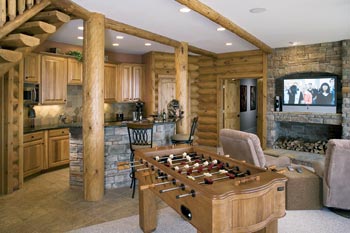 Basements offer great storage opportunities, so consider your storage needs thoroughly during the design stage. If you're storing large items, consider using double doors that lead into the storage area; they're little luxuries that go a long way aesthetically. If you'll use storage areas for crafts or hobbies, be sure to include enough electrical outlets and plenty of light. You also might want to consider setting aside an area for electrical equipment such as wireless router and media wiring. Of course, don't forget built-in cabinets and abundant shelving.
Basements offer great storage opportunities, so consider your storage needs thoroughly during the design stage. If you're storing large items, consider using double doors that lead into the storage area; they're little luxuries that go a long way aesthetically. If you'll use storage areas for crafts or hobbies, be sure to include enough electrical outlets and plenty of light. You also might want to consider setting aside an area for electrical equipment such as wireless router and media wiring. Of course, don't forget built-in cabinets and abundant shelving.
7. Temperature extremes always seem to haunt a basement—it’s either too cold or too humid. What are the best ways to combat this? Temperature extremes are behind much of the "damp basement" syndrome. Cooler basement temperatures means higher humidity and the clamminess it brings. Insulate your basement thoroughly either inside or outside foundation walls and under the slab. Make sure your basement is well heated with radiant-floor heat or forced air. Try to match the basement's air temperatures to those on the main level of your home. Remember, cool basements also can work to your advantage: they're a great summer retreat in sticky climates. If you're thinking about cost efficiency (and why shouldn't you be?), a basement is money in the proverbial bank. For a modest investment, you'll gain plenty of storage, a place to house your mechanicals (think HVAC) and, perhaps most important, an escape to watch the big game or play a little pool with an old friend.

1. What are the best flooring materials for my basement? The least expensive basement floor is…concrete. Surprised? Many folks are, but it’s really a smart choice for some houses. If you plan to use concrete as a finished surface, be sure to tell the contractor that you want a “troweled” finish, which will be much smoother than the utility surface found in unfinished basements. Consider using dyed concrete, and be sure you or your contractor applies a sealant while the floor is clean. It will be hard to remove the effects of construction traffic and debris from an unsealed floor when construction is completed. If you plan to use your concrete slab as a finished floor, ask your contractor to place a layer of rigid insulation and radiant barrier beneath the slab. This also is one of the most economical ways to add radiant-floor heat to your home. Of course, you aren’t limited to concrete for your finished floor. Stone and tile add elegant touches, but they also hit your budget harder. Carpet and vinyl flooring provide economical alternatives. If you elect to use wood, be sure to isolate the wood away from the dampness of the concrete slab. And you might play it safe and go with engineered wood, since it’s not as prone to shift in response to changes in temperature and humidity than solid wood.
2. What are the advantages of finishing the basement when we first build our house? When you finish your basement during construction, all of the subcontractors are already onsite, which means they can offer you (or, most likely, your builder) their best price. Finishing early also means that your basement layout will be integrated into the rest of construction. Subcontractors will be able to work more efficiently, use fewer materials and resolve issues such as pipe and wire placement as they arise—rather than leaving something that will create problems during future construction. Bottom line: To get the biggest bang for your home-buying buck, finish the basement at the time of construction.
3. If I choose to hold off on finishing my log home basement because of budgetary constraints, what should my contractor do to ensure a smooth finishing process in several years? First, even if you’re not finishing your basement during construction, create a plan now that identifies those elements, such as bathroom drain lines, that are best installed during initial construction. Also, when it comes to your blueprints, be sure your designer marks those areas of the house that will be built in the future. This way, building-permit officials won’t charge you twice (now and later) for approving your paperwork. (Note: In some parts of the country, if those areas aren’t marked, your builder will have to complete all rooms in the house—even those you wanted to finish later.) Keep your basement plan in a safe place until construction time arrives. Nothing is more frustrating than knowing there’s a drain somewhere under all that concrete — you’re just not sure where! Plumbing groundwork, including drain lines and drains, should be installed when you construct your basement so they can be tied into the overall drainage systems. Electrical wiring usually can be added later, but you might want to have the electrician designate several areas in your electrical panel for basement circuits. You also should have rigid insulation installed outside your foundation walls during construction, which will help reduce heating and cooling requirements.
4. Basements often feel like dungeons. I want a space that’s bright, dynamic, and rustic—just like the rest of my house. How do I accomplish this?
 Two things help overcome the “dungeon effect” of basement living spaces. Insulation and windows. Many people associate the damp chill of many basements with the fact that these spaces are underground. While there’s some truth to this, dampness comes not from the ground but from the cooler temperatures found in most below-grade basements. By boosting your basement’s insulation, you can reduce the temperature difference from upper levels of your house. Windows, especially those facing south, can warm your basement significantly by reducing humidity. They also increase ventilation and create a bright, airy space.
Two things help overcome the “dungeon effect” of basement living spaces. Insulation and windows. Many people associate the damp chill of many basements with the fact that these spaces are underground. While there’s some truth to this, dampness comes not from the ground but from the cooler temperatures found in most below-grade basements. By boosting your basement’s insulation, you can reduce the temperature difference from upper levels of your house. Windows, especially those facing south, can warm your basement significantly by reducing humidity. They also increase ventilation and create a bright, airy space. A number of pre-fabricated basement systems have gained popularity for their ease of construction and energy efficiency. Talk to your builder about wood foundations, pre-cast concrete and insulated concrete forms (ICFs). Options vary nationwide, so what works in one location may not be best in another. As you consider your home site, look for ways to incorporate a walkout basement. As little as 4 feet of height difference between one side of your home and the opposite provides enough space for windows. A difference of 6 to 8 feet will allow you to create a walkout basement with its own entrance. Daylight basements allow you to open windows and circulate fresh air. This also reduces potential problems from radon, a carcinogenic gas found in many areas of the country. If you live in a high-radon area or will have a finished basement with little outside ventilation, you should have your contractor do the preliminary installation for a sub-slab ventilation system. When your home is finished, a radon test will let you know whether you need to connect mechanical ventilation to your system.
5. Are there any special considerations I need to keep in mind when building higher basement ceilings? Do they cost more? High ceilings help dispel the dungeon effect. Nine- or 10-foot ceilings add only the cost of increased wall height and possibly slightly larger foundations. This may amount to only a few thousand dollars for turning your basement into truly comfortable living space. Ductwork for your HVAC is typically run through the basement ceiling. These overhead ducts take up ceiling space and add to that tunnel sensation found in many basements. Raising ceiling heights allows you to conceal ductwork while maintaining a comfortable ceiling height.
6. Our basement will house a media/game room, but we’re also looking to use this space for storage. What should we keep in mind when planning?
 Basements offer great storage opportunities, so consider your storage needs thoroughly during the design stage. If you're storing large items, consider using double doors that lead into the storage area; they're little luxuries that go a long way aesthetically. If you'll use storage areas for crafts or hobbies, be sure to include enough electrical outlets and plenty of light. You also might want to consider setting aside an area for electrical equipment such as wireless router and media wiring. Of course, don't forget built-in cabinets and abundant shelving.
Basements offer great storage opportunities, so consider your storage needs thoroughly during the design stage. If you're storing large items, consider using double doors that lead into the storage area; they're little luxuries that go a long way aesthetically. If you'll use storage areas for crafts or hobbies, be sure to include enough electrical outlets and plenty of light. You also might want to consider setting aside an area for electrical equipment such as wireless router and media wiring. Of course, don't forget built-in cabinets and abundant shelving. 7. Temperature extremes always seem to haunt a basement—it’s either too cold or too humid. What are the best ways to combat this? Temperature extremes are behind much of the "damp basement" syndrome. Cooler basement temperatures means higher humidity and the clamminess it brings. Insulate your basement thoroughly either inside or outside foundation walls and under the slab. Make sure your basement is well heated with radiant-floor heat or forced air. Try to match the basement's air temperatures to those on the main level of your home. Remember, cool basements also can work to your advantage: they're a great summer retreat in sticky climates. If you're thinking about cost efficiency (and why shouldn't you be?), a basement is money in the proverbial bank. For a modest investment, you'll gain plenty of storage, a place to house your mechanicals (think HVAC) and, perhaps most important, an escape to watch the big game or play a little pool with an old friend.




